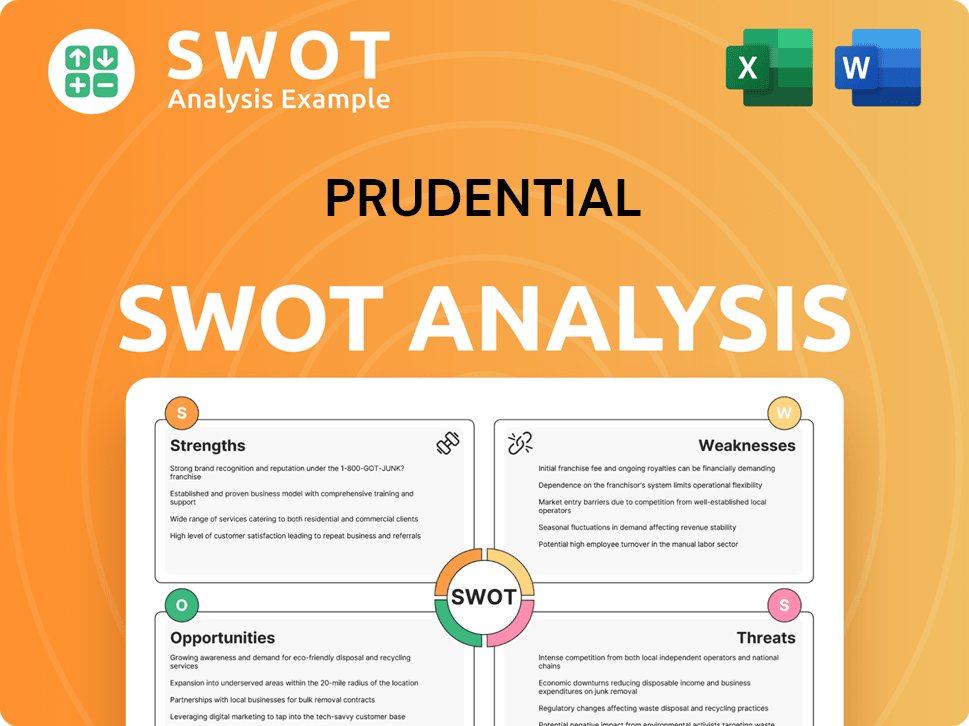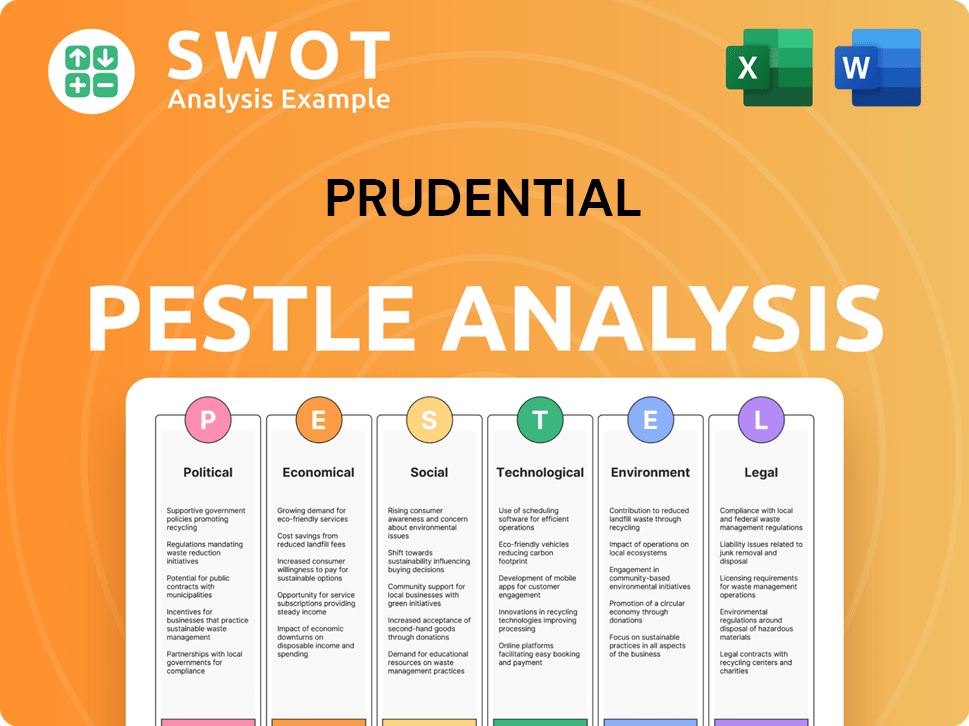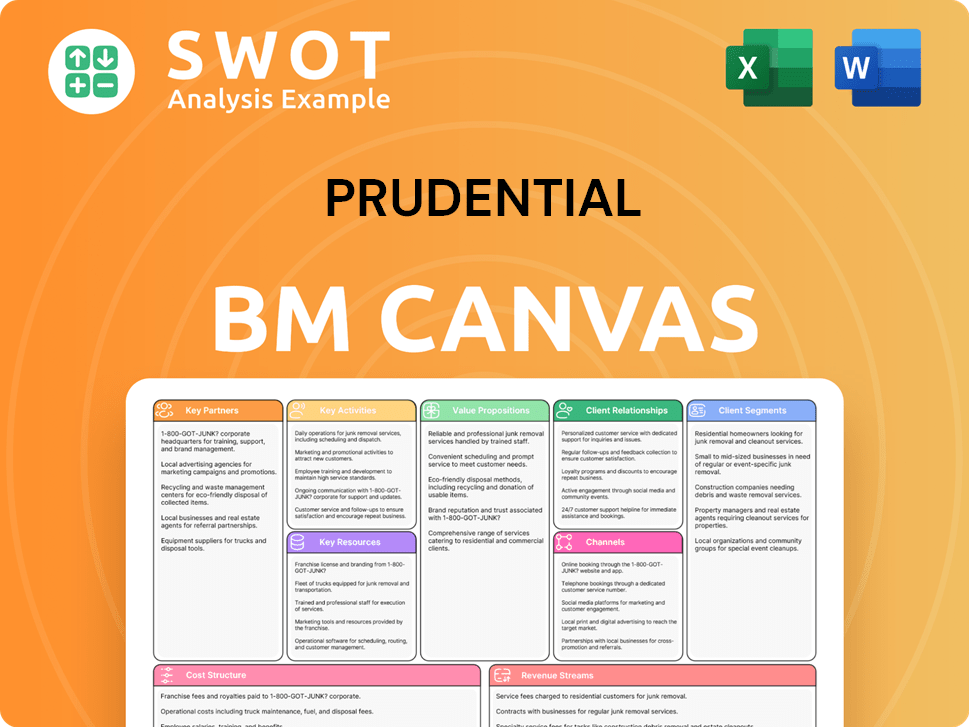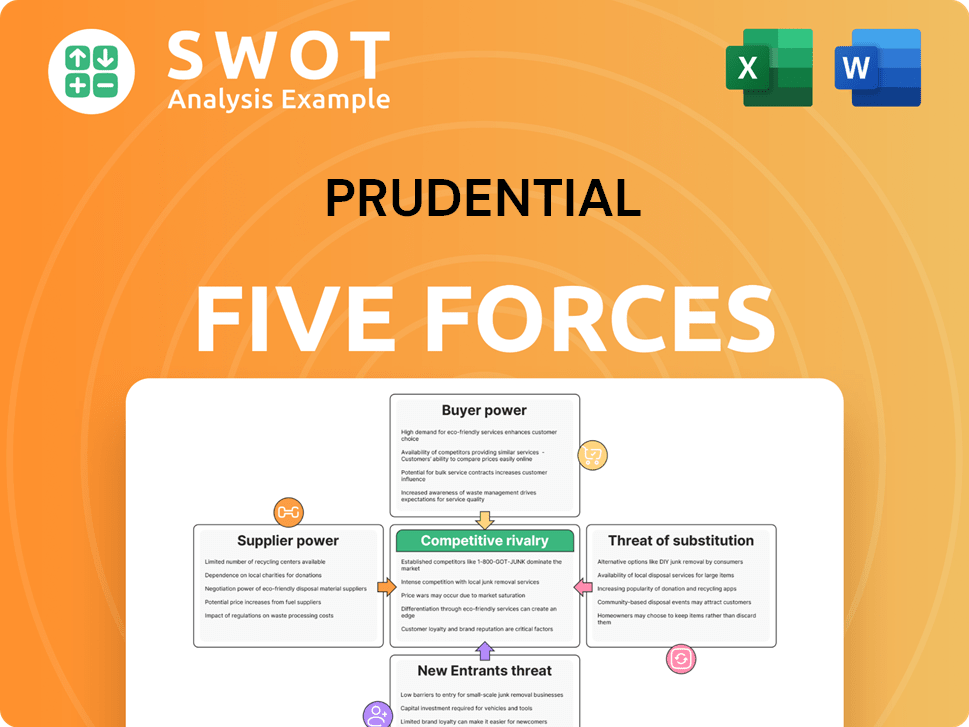Prudential Bundle
Who Really Owns Prudential?
Unraveling the ownership of a financial giant like Prudential plc is key to understanding its future. From its humble beginnings in 1848 to its current global presence, Prudential's ownership has undergone significant transformations. Knowing who controls Prudential is critical for investors, analysts, and anyone interested in the financial landscape.

This deep dive into Prudential ownership will explore its historical roots and its evolution through key milestones. We'll examine the influence of major shareholders, the impact of strategic decisions, and the company's current Prudential SWOT Analysis. Understanding the Prudential ownership structure is essential for assessing its financial performance and strategic direction. We'll also touch upon the questions like: Who is the CEO of Prudential, and is Prudential a publicly traded company?
Who Founded Prudential?
The story of Prudential begins in 1848 in London's Hatton Garden. It was founded by a group of individuals with a shared vision: to provide accessible life insurance to the working class. While the exact details of the initial ownership structure aren't fully available in historical records, the company's origins are rooted in the efforts of benevolent capitalists and social reformers.
Early ownership of Prudential was shaped by its initial structure as a mutual assurance society. This meant it was technically owned by its policyholders, not external shareholders. Profits were distributed among policyholders, reflecting a focus on collective benefit rather than individual profit. This model significantly influenced the company's early governance and the distribution of benefits.
The founders pooled their capital to establish 'The Prudential Mutual Assurance, Investment and Loan Association.' These early backers held significant influence in the company's formative years. Their focus was on the governance of the mutual society and the distribution of benefits to policyholders, rather than traditional equity stakes. This reflected the founding team's commitment to providing financial security to ordinary people.
Prudential was founded in 1848 in London.
The company initially operated as a mutual assurance society.
Control rested with a board elected by and representing policyholders.
The company was founded by a collective of benevolent capitalists and social reformers.
Profits were distributed among policyholders.
Early backers contributed the initial capital for its establishment.
Understanding the early ownership structure of Prudential is crucial for grasping its evolution. The company's initial form as a mutual society, with policyholders as its owners, set the stage for its long-term success. The founders' commitment to social reform and financial security for the working class shaped its early governance and operational principles, as discussed in Brief History of Prudential.
- The company's initial focus was on providing accessible life insurance.
- Early governance was managed by a board elected by policyholders.
- The mutual structure meant profits were distributed among policyholders.
- The founding team's vision prioritized collective benefit over individual profit.
Prudential SWOT Analysis
- Complete SWOT Breakdown
- Fully Customizable
- Editable in Excel & Word
- Professional Formatting
- Investor-Ready Format

How Has Prudential’s Ownership Changed Over Time?
The evolution of the ownership structure of Prudential plc marks a significant transformation. Initially operating as a mutual company, it demutualized in 1986 and became a publicly listed entity on the London Stock Exchange. This pivotal move enabled external investors to acquire shares, shifting the governance from a policyholder-centric model to a shareholder-centric one. This transition was a critical step in Prudential's company history, opening the door for institutional investors to become major stakeholders.
In recent years, Prudential's ownership has continued to evolve, particularly after its strategic focus on Asia and Africa and the demerger of Jackson Financial Inc. in 2021. This strategic pivot has influenced the company's direction, leading to targeted investments in these regions and a streamlined operational focus. The changes in ownership have also resulted in a more geographically diverse investor base, with growing interest from Asian and North American institutional investors.
| Key Event | Impact on Ownership | Year |
|---|---|---|
| Demutualization and IPO | Transition from mutual to publicly listed company, allowing external investment. | 1986 |
| Strategic Focus on Asia and Africa | Attracted a more geographically diverse investor base, with increased interest from Asian and North American institutional investors. | Ongoing (post-2021) |
| Demerger of Jackson Financial Inc. | Streamlined operational focus, potentially altering the composition of major shareholders. | 2021 |
As of early 2025, Prudential's ownership is primarily held by a diverse group of institutional investors. Major shareholders often include large asset management firms and index funds. For instance, BlackRock, Vanguard Group, and Capital Group are among the major institutional holders, collectively holding significant percentages of the company's shares. These large institutional holdings can represent anywhere from 3% to over 5% individually. Individual insider ownership is generally a smaller percentage, consistent with large, widely held public companies. To understand more about the company's strategic direction, you can read about the Growth Strategy of Prudential.
Prudential's ownership structure has evolved significantly since its demutualization in 1986.
- The company is now primarily owned by institutional investors.
- Major shareholders include firms like BlackRock and Vanguard.
- The strategic focus on Asia and Africa has influenced the investor base.
- Understanding who owns Prudential is crucial for assessing its financial performance.
Prudential PESTLE Analysis
- Covers All 6 PESTLE Categories
- No Research Needed – Save Hours of Work
- Built by Experts, Trusted by Consultants
- Instant Download, Ready to Use
- 100% Editable, Fully Customizable

Who Sits on Prudential’s Board?
As of early 2025, the Board of Directors of Prudential plc includes a mix of executive and non-executive directors. These directors bring extensive experience in the financial services sector, crucial for guiding the company's operations. The board's structure is designed to provide independent oversight and strategic direction, benefiting the overall shareholder base. The current board members are selected for their expertise and ability to align with the interests of the broader shareholder base. This structure supports transparent governance and accountability.
The board includes independent non-executive directors alongside those with deep industry experience. While specific board members representing individual major shareholders are not typically appointed, the non-executive directors are chosen for their expertise and ability to provide independent oversight and strategic guidance. This approach helps ensure a balanced perspective in decision-making. The Marketing Strategy of Prudential is also influenced by the board's decisions.
| Board Role | Description | Focus |
|---|---|---|
| Executive Directors | Individuals with operational responsibilities within the company. | Day-to-day management and execution of strategy. |
| Non-Executive Directors | Independent members providing oversight and strategic guidance. | Ensuring accountability and representing shareholder interests. |
| Independent Non-Executive Directors | Directors without any executive role, offering unbiased perspectives. | Providing independent oversight and ensuring good governance. |
The voting structure of Prudential plc adheres to a one-share-one-vote principle. This means each ordinary share carries one vote, ensuring voting power is proportional to share ownership. There are no known dual-class shares or special voting rights that would grant outsized control to specific entities. This structure promotes equitable distribution of voting power among shareholders. This approach supports transparent governance and accountability to its wide array of shareholders. The focus has largely been on executing its strategy in Asia and Africa and managing the demerger of its US operations. The company's focus on its shareholders is evident in its structure.
Prudential's board includes a mix of executive and non-executive directors, ensuring diverse expertise. The voting structure follows a one-share-one-vote principle, promoting equitable shareholder power.
- The board's composition supports transparent governance.
- Voting rights are proportional to share ownership.
- Prudential's governance aims to balance stakeholder interests.
- Non-executive directors provide independent oversight.
Prudential Business Model Canvas
- Complete 9-Block Business Model Canvas
- Effortlessly Communicate Your Business Strategy
- Investor-Ready BMC Format
- 100% Editable and Customizable
- Clear and Structured Layout

What Recent Changes Have Shaped Prudential’s Ownership Landscape?
Over the past few years, significant changes have reshaped the ownership profile of Prudential plc. A key event was the demerger of Jackson Financial Inc. in September 2021, its U.S. business. This strategic move resulted in Jackson becoming an independent entity, listed separately, and it significantly altered Prudential plc's asset base and geographical focus. This shift allowed Prudential to concentrate on its high-growth markets in Asia and Africa.
The demerger likely led to a redistribution of ownership. Some investors may have held shares in both entities, while others may have divested from one to focus on the other. This has led to an increase in institutional ownership, especially from global asset managers, who recognize the growth potential in Prudential's core markets. As of early 2025, the company continues to demonstrate strong financial performance in its target markets, which reinforces investor confidence and maintains its current ownership structure. The ongoing trend is towards optimizing its capital structure and leveraging its strong market position in Asia and Africa to drive future growth, attracting long-term institutional investment. For more information, you can also explore the Competitors Landscape of Prudential.
| Ownership Category | Approximate Percentage (Early 2025) | Notes |
|---|---|---|
| Institutional Investors | Around 60-70% | Includes asset managers, pension funds, and other institutional holders. |
| Retail Investors | Around 20-30% | Individual shareholders holding smaller portions of the stock. |
| Other | Remaining percentage | May include company insiders and other entities. |
The focus for Prudential is on its strong market position in Asia and Africa, which continues to attract long-term institutional investment. The company is already publicly traded, and there are no immediate plans for privatization or a new public listing. Prudential's financial performance in its target markets reinforces investor confidence and maintains its current ownership structure.
Prudential is primarily owned by institutional investors, with a significant portion held by asset managers and pension funds. Retail investors also hold a considerable amount of shares. The ownership structure reflects a focus on long-term growth.
Major investors include large institutional holders who see value in Prudential's strategic focus on Asia and Africa. The shareholder base is diversified, with a mix of institutional and retail investors. The company's stock symbol is PRU.
The ownership structure is primarily influenced by institutional investors, reflecting the company's strategic focus. Founder dilution is a natural result of growth. The company is publicly traded, and its ownership is subject to market dynamics.
Prudential's executives manage the company's strategic direction. The board of directors oversees corporate governance. Understanding the leadership is crucial for assessing the company's performance.
Prudential Porter's Five Forces Analysis
- Covers All 5 Competitive Forces in Detail
- Structured for Consultants, Students, and Founders
- 100% Editable in Microsoft Word & Excel
- Instant Digital Download – Use Immediately
- Compatible with Mac & PC – Fully Unlocked

Related Blogs
- What are Mission Vision & Core Values of Prudential Company?
- What is Competitive Landscape of Prudential Company?
- What is Growth Strategy and Future Prospects of Prudential Company?
- How Does Prudential Company Work?
- What is Sales and Marketing Strategy of Prudential Company?
- What is Brief History of Prudential Company?
- What is Customer Demographics and Target Market of Prudential Company?
Disclaimer
All information, articles, and product details provided on this website are for general informational and educational purposes only. We do not claim any ownership over, nor do we intend to infringe upon, any trademarks, copyrights, logos, brand names, or other intellectual property mentioned or depicted on this site. Such intellectual property remains the property of its respective owners, and any references here are made solely for identification or informational purposes, without implying any affiliation, endorsement, or partnership.
We make no representations or warranties, express or implied, regarding the accuracy, completeness, or suitability of any content or products presented. Nothing on this website should be construed as legal, tax, investment, financial, medical, or other professional advice. In addition, no part of this site—including articles or product references—constitutes a solicitation, recommendation, endorsement, advertisement, or offer to buy or sell any securities, franchises, or other financial instruments, particularly in jurisdictions where such activity would be unlawful.
All content is of a general nature and may not address the specific circumstances of any individual or entity. It is not a substitute for professional advice or services. Any actions you take based on the information provided here are strictly at your own risk. You accept full responsibility for any decisions or outcomes arising from your use of this website and agree to release us from any liability in connection with your use of, or reliance upon, the content or products found herein.